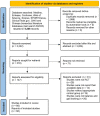The effect of balance and gait training on specific balance abilities of survivors with stroke: a systematic review and network meta-analysis
- PMID: 38020595
- PMCID: PMC10653323
- DOI: 10.3389/fneur.2023.1234017
The effect of balance and gait training on specific balance abilities of survivors with stroke: a systematic review and network meta-analysis
Abstract
Background: Stroke, which is a common clinical cerebrovascular disease, causes approximately 83% of survivors to suffer from balance impairments. Balance and gait training (BGT) is widely used to restore balance in patients with stroke. However, its wide variety presents clinicians with a dilemma when selecting interventions. This study aimed to compare and rank BGT interventions by quantifying information based on randomized controlled trials (RCTs).
Methods: We conducted a network meta-analysis (NMA) of non-gait-trained controls and head-to-head RCTs and compared the effects of 12 BGT interventions. A total of nine literature databases, including Medline, Embase, Cochrane Library, Web of Science, Scopus, SPORTDiscus, ClinicalTrials.gov, CNKI, and Chinese biomedical literature databases, were searched from their database inception to August 2023. Two authors independently selected studies and extracted data. The difference in outcomes, which were expressed as standardized mean differences and confidence intervals (CIs) of 95%, were explored in this meta-analysis.
Results: A total of 66 studies with 1,933 participants were included. Effect size estimates showed that not all BGT interventions were more effective than controls, with treadmill training as the least effective for balance test batteries (SMD = -0.41, 95% CI [-1.09, 0.27]) and proactive balance (SMD = -0.50, 95% CI [-1.14, 0.14]). Body-weight-supported treadmill training with external stimulation was most effective for proactive balance and dynamic steady-state balance (SMD = 1.57, 95% CI [-0.03, 3.16]); SMD = 1.18, 95% CI [0.67, 1.68]. Virtual reality gait training (SMD = 1.37, 95% CI [0.62, 2.11]) had the best effect on improving balance test batteries, while dual-task BGT (SMD = 1.64, 95% CI [0.50, 2.78]) had the best effect on static steady-state balance. After analyses for possible impact covariates, the findings through the outcomes did not change substantially. Confidence in the evidence was generally low or very low.
Conclusion: This NMA suggested that virtual reality gait training was the most effective BGT modality for improving balance test batteries. Body-weight support treadmill training with external stimulation was the most effective for improving active and dynamic balance. In addition, dual-task BGT was the best choice for improving static balance. However, balance is a multidimensional concept, and patients' different needs should be considered when selecting BGT.
Systematic review registration: https://www.crd.york.ac.uk/prospero/display_record.php?ID=CRD42022316057, ID: CRD42022316057.
Keywords: balance; gait; network meta-analysis; rehabilitation; stroke.
Copyright © 2023 Zhang, Liang, Li, Meng, Jiang, Xu, Li and Liu.
Conflict of interest statement
The authors declare that the research was conducted in the absence of any commercial or financial relationships that could be construed as a potential conflict of interest.
Figures


Similar articles
-
Comparative efficacy of gait training for balance outcomes in patients with stroke: A systematic review and network meta-analysis.Front Neurol. 2023 Apr 3;14:1093779. doi: 10.3389/fneur.2023.1093779. eCollection 2023. Front Neurol. 2023. PMID: 37077566 Free PMC article. Review.
-
Effects of body weight support training on balance and walking function in stroke patients: a systematic review and meta-analysis.Front Neurol. 2024 Aug 27;15:1413577. doi: 10.3389/fneur.2024.1413577. eCollection 2024. Front Neurol. 2024. PMID: 39258157 Free PMC article.
-
Effects of virtual reality rehabilitation training on gait and balance in patients with Parkinson's disease: A systematic review.PLoS One. 2019 Nov 7;14(11):e0224819. doi: 10.1371/journal.pone.0224819. eCollection 2019. PLoS One. 2019. PMID: 31697777 Free PMC article.
-
Effect of Tai Chi Yunshou training on the balance and motor functions of stroke patients: a systematic review and meta-analysis of randomized controlled trials.Front Neurol. 2023 May 12;14:1178234. doi: 10.3389/fneur.2023.1178234. eCollection 2023. Front Neurol. 2023. PMID: 37251239 Free PMC article. Review.
-
The difference between the effectiveness of body-weight-supported treadmill training combined with functional electrical stimulation and sole body-weight-supported treadmill training for improving gait parameters in stroke patients: A systematic review and meta-analysis.Front Neurol. 2022 Nov 9;13:1003723. doi: 10.3389/fneur.2022.1003723. eCollection 2022. Front Neurol. 2022. PMID: 36438963 Free PMC article.
Cited by
-
Dual Tasking Affects the Outcomes of Instrumented Timed up and Go, Sit-to-Stand, Balance, and 10-Meter Walk Tests in Stroke Survivors.Sensors (Basel). 2024 May 9;24(10):2996. doi: 10.3390/s24102996. Sensors (Basel). 2024. PMID: 38793850 Free PMC article.
References
-
- Dicker D, Nguyen G, Abate D, Abate KH, Abay SM, Abbafati C, et al. . Global, regional, and national age-sex-specific mortality and life expectancy, 1950-2017: a systematic analysis for the global burden of disease study 2017. Lancet. (2018) 392:1684–735. doi: 10.1016/s0140-6736(18)31891-9, PMID: - DOI - PMC - PubMed
-
- Roth GA, Abate D, Abate KH, Abay SM, Abbafati C, Abbasi N, et al. . Global, regional, and national age-sex-specific mortality for 282 causes of death in 195 countries and territories, 1980-2017: a systematic analysis for the global burden of disease study 2017. Lancet. (2018) 392:1736–88. doi: 10.1016/s0140-6736(18)32203-7, PMID: - DOI - PMC - PubMed
-
- James SL, Abate D, Abate KH, Abay SM, Abbafati C, Abbasi N, et al. . Global, regional, and national incidence, prevalence, and years lived with disability for 354 diseases and injuries for 195 countries and territories, 1990-2017: a systematic analysis for the global burden of disease study 2017. Lancet. (2018) 392:1789–858. doi: 10.1016/s0140-6736(18)32279-7, PMID: - DOI - PMC - PubMed
-
- Feigin VL, Stark BA, Johnson CO, Roth GA, Bisignano C, Abady GG, et al. . Global, regional, and national burden of stroke and its risk factors, 1990-2019: a systematic analysis for the global burden of disease study 2019. Lancet Neurol. (2021) 20:795–820. doi: 10.1016/s1474-4422(21)00252-0, PMID: - DOI - PMC - PubMed
Publication types
LinkOut - more resources
Full Text Sources

